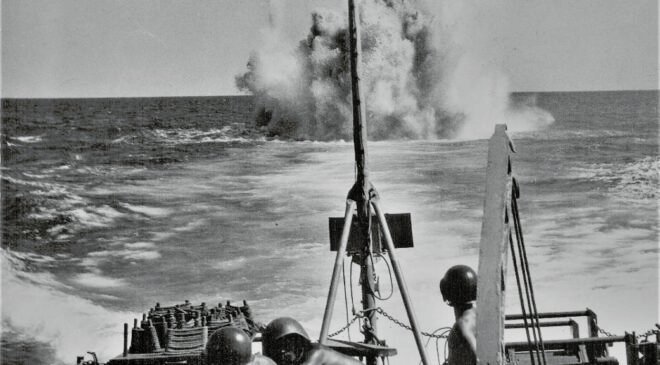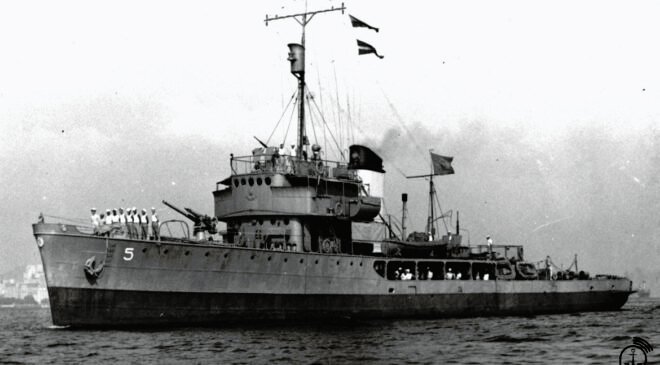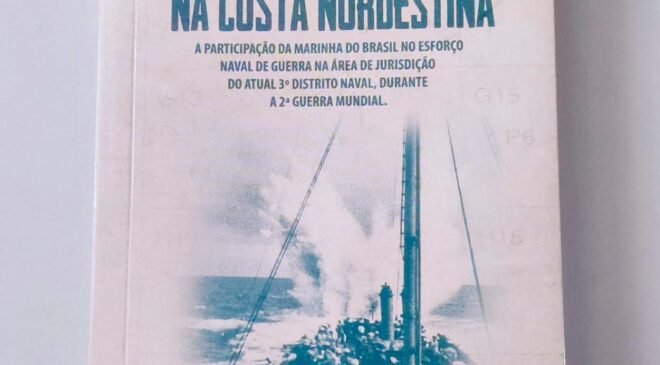80 years ago, the Northeast Naval Force (FNNE) was created, by Notice No. 661 of October 5, 1942. This was a quick response to the reorganization process of the Brazilian Navy (MB) to adapt to the conflict situation caused by World War II. The Brazilian participation in the war was even marked by the sacrifice of anonymous heroes who gave their lives for the nation.
The newly created Force was initially composed of the following ships: Cruisers “Bahia” and “Rio Grande do Sul”; Minas Gerais “Carioca”, “Caravelas”, “Camaquã” and “Cabedelo” (later reclassified as corvettes); and the Submarine-Busters “Guaporé” and “Gurupi”. FNNE also received ships that had just been ready by Brazilian shipyards and several anti-submarine escort ships ceded by the Americans; being part of Task Force 46 of the South Atlantic Force, subordinated to the 4th U.S. Squadron, bringing together MB with the United States Navy, which had been battling the submarine threat since 1941.

To expand the theme, The Captain of Sea and War (Intendant of the Navy) João Ferreira Leal Neto granted an interview to the Marine News Agency about the performance of FNNE, which contributed to the free movement in the navigation lines of the South Atlantic against the action of submarines and enemy ships. He is the author of the book “Naval War on the Northeastern Coast – The participation of the Brazilian Navy in the naval war effort in the area of jurisdiction of the current 3rd Naval District (Ceará to Alagoas) during World War II”, launched in May of this year.


Captain of Sea and War João Ferreira Leal Neto, author of the book
Can you explain what motivated the creation of the Northeast Naval Force?
The history of the Northeast Naval Force began in January 1942, when the Brazilian Navy decided to strengthen the defense of the Brazilian coast in the Northeast Region, already predicting that there would probably be enemy incursions in that maritime area in the following months. In this sense, there was the decision to send, to patrol the northeastern coast, a Naval Force, called Cruisers Division, under the Command of Rear Admiral Jorge Dodsworth, composed of ships that belonged to the Brazilian Squadron that was based in Rio de Janeiro.
After a few months, in September 1942, already under the command of the then Captain of Sea and War Alfredo Carlos Soares Dutra, that Naval Force, as a result of an agreement between the Governments of Brazil and the United States of America (USA), would be operationally subordinated to the North American Squadron operating in the South Atlantic, whose Command was based in Recife (PE), receiving, on this occasion, the functional name of “Task Force 46” of the South Atlantic Squadron.
The following month, on October 5, 1942, by Notice No. 1,661/42, the former Cruisers Division would be officially named “Northeast Naval Force”, remaining with this name until its extinction in November 1945.
There were several factors that motivated the Navy’s decision to strengthen the defense of the northeastern coast, with the creation of a specific Naval Force to patrol the region, in addition to agreeing to participate in a military alliance with the U.S., and it is worth mentioning the following:
– The entry of the United States into World War II, on December 7, 1941, after the Japanese attack on the Naval Base of Pearl Harbor, made it impossible for Brazil to remain totally neutral to the conflict, as international agreements related to the mutual defense of the American continent in cases of external aggression were in force. Thus, on February 28, 1942, Brazil would break diplomatic relations with the Axis countries (Germany, Italy and Japan) and, after a series of sinking of Brazilian ships by German and Italian submarines, declared, on August 22, 1942, war on Germany and Italy;
– The naval strategy adopted by the two European Axis countries (Germany and Italy), mainly from 1942, to attack the allied merchant navy, with the aim of interrupting the flow of supplies from the Americas to England and the Soviet Union, aiming to weaken the war effort of these enemy countries, led to the intensification of naval actions in the atlantic maritime area. These attacks were carried out mainly by submarines and resulted in the sinking of hundreds of ships of various nationalities, including: a fishing boat and 31 Brazilian merchant ships, in addition to a warship of our Navy – the Auxiliary Ship (NA) “Vital de Oliveira”–, with a total of 1082 lives lost.
It should be noted that, in addition to the NA “Vital de Oliveira”, two more warships were lost during the conflict: the Corvette “Camaquã” and the Cruiser “Bahia”.
In this context, it was fundamental for the stability of the Brazilian economy, very dependent on international maritime trade, in addition to the supply of coastal cities, carried out mainly via cabotage navigation, that maritime traffic along the coast be kept safe against enemy natains, hence the need for the Brazilian Navy to implement actions aimed at maintaining this security; and
– The states of Rio Grande do Norte, Paraíba and Pernambuco, because they were located near the eastern end of the South American coast and, thus, the regions of the Americas closest to the West African coast, made the Northeast a very important strategic point at a time when the aircraft had low flight autonomy and were taking decisive battles between the Allied forces and the Axis for control of North Africa. So much so, that the U.S. had great military interest in the region and already had, in early 1942, with the consonance of the Brazilian Government, established important military bases on the site, such as: the Parnamirim Air Base (Parnamirim Field), near Natal (RN), and the Fox Naval Base, in Recife, which would be, throughout the war period, the south Atlantic Squadron Command, then named 4th U.S. Squadron.
In this context, the Brazilian Navy, during World War II, also had to devote special attention to the defense of this strategic area of the Brazilian coast, expanding, for example, the number of military organizations in the region, with the creation of the Northeast Naval Command (later Command of the 3rd Naval District); creating the Naval Base of Natal, the Naval Hospital of Natal and the 3rd Regional Company of Marines of Natal (then Group of Christmas Marines), in addition to, aforementioned, sending to the Northeast of a Naval Force, which after a few months would be operationally subordinated to the North American South Atlantic Squadron and would be called the Northeast Naval Force.

 What was the Navy’s mission in this historical context?
What was the Navy’s mission in this historical context?
Brazil at the time of World War II was still an undeveloped country, very lacking in roads, where the main cities were located, mostly, close to the coast and communication between them was basically by sea. These urban centers were, then, as islands of an archipelago, where the main flow, both cargo and people, was made by ships, national or foreign, making the economy and supply of these places totally dependent on maritime traffic made along the Brazilian coast.
Thus, with the intensification of naval warfare in the South Atlantic, mainly from August 1942, when six Brazilian ships were sunk near the coasts of Sergipe and Bahia, and Brazil declared war on Germany and Italy, the Brazilian Navy was given the mission to protect the sea routes and merchant and fishing vessels that were sailing along the Brazilian coast, trade flows to be impaired or disrupted for security reasons.
To provide this security it was necessary to implement a series of measures, such as: greater control of access to port areas; reduction of urban lighting in places near ports and fundeadouros to make it difficult to see targets by submarines; and mainly to compel ships to only sail in convoys, and it is up to the Navy’s marine means to carry out the escorts that would protect these vessels from enemy attacks.
In this sense, the Brazilian foreign policy, conducted by President Getúlio Vargas, was decisive, because it was able to defend the national objectives, using as the main exchange currency the American interest in establishing military bases in Brazilian territory, especially in the Northeast of the country. These bases were fundamental to logistical support to the marine and air media that were being employed in the Southern Hemisphere and their existence would be decisive for the allied victory.
Thus, the Brazilian Navy was able to acquire 24 ships over the years 1942 to 1945 that were immediately used in war operations, in addition to enabling the modernization of various means, with the acquisition of various weapons and equipment, in addition to sending dozens of military personnel abroad to carry out the most diverse types of training.
However, at the very beginning of the operations, aware that the Brazilian Navy, due to personnel and material deficiencies, was unable to carry out the enormous mission assigned to it alone, there was the decision to transfer the Operational Command of the marine forces operating on the Brazilian coast to the South Atlantic Fleet, then 4th U.S. Police Station, a portion of the U.S. Navy that was operating in the Southern Hemisphere and whose main base was the city of Recife. Thus, the Cruisers Division, then the Northeast Naval Force, became functionally known as “Task Force 46” and was assigned to it as its main mission: to provide escorts to convoys formed by merchant ships sailing on the northeastern coast toward Trinidad and Tobago in the Caribbean, and vice versa.
It is noteworthy that the Brazilian Navy has achieved great success in fulfilling the mission assigned to it, with the Ships of the Northeast Naval Force sailing more than 600,000 nautical miles and escorted 3,164 domestic and foreign merchant ships in 575 convoys that transported 16 million tons of supplies to the Allies.
In conclusion, I would like to mention the words of a veteran of the Northeast Naval Force, Lieutenant Captain Helio Leoncio Martins, who, in my opinion, summarizes masterfully what was the performance of the Brazilian Navy during World War II. “The war we fought at sea against the Axis submarines did not include heroic moves, nor exciting encounters with the enemy. It characterized the relevance with which anti-submarine ships remained at sea, in defense of merchants, and the willingness to face the monotony of the comings and goings of trains.”


Now about the book you published, what inspired you to write about it?
The motivation for the creation of this book began when I started my graduation in History at the Federal University of Rio Grande do Norte (UFRN). During the course, I was very bothered by the lack of interest and ignorance of teachers and colleagues for the topics related to naval history. In the classes and wheels of conversations in which I participated, when, for example, there was talk about the Second World War, the little knowledge that was limited to the performance of FEB in Italy, or some stories about the Parnamirim Air Base (Parnamirim Field), nothing being said about the navy’s performance in the defense of the northeastern coast. On those occasions, I surprised everyone when I informed them that there were more sailors from our Navy killed in the conflict than FEB soldiers in Italy.
Thus, since that time, it had been fueling interest in the theme and the willingness to publish a text that would someday publish a text that addressed the Navy’s participation in the conflict.
The book discusses the strategic importance and interest of the U.S. Armed Forces in northeastern Brazil, Brazil’s entry into World War II, the situation of the Brazilian Navy at the beginning of the conflict and the actions that were taken to improve the material situation and training of personnel, the creation of the current Military Organizations of the 3rd Naval District, the creation and performance of the Naval Force of the Northeast, describes the sinking of the three warships that occurred during the conflict (the Auxiliary Ship “Vital de Oliveira”; the Corvette “Camaquã”; and the “Cruiser Bahia”) and reports the sacrifice and acts of heroism experienced by our veterans who garnished the Brazilian warships in the various operations that occurred during the period.

 Thus, the desire is that this book, in some way, can contribute to the appreciation of the history of the Navy in World War II, in particular, to the resgaste of anonymous heroes, sailors who spent long days aboard ships without any comfort, many sacrificing their lives in the strict fulfillment of duty.
Thus, the desire is that this book, in some way, can contribute to the appreciation of the history of the Navy in World War II, in particular, to the resgaste of anonymous heroes, sailors who spent long days aboard ships without any comfort, many sacrificing their lives in the strict fulfillment of duty.
Ship-Museum “Bauru”
The Ship-Museum “Bauru’ is one of the attractions of the Navy Cultural Space, on the Olympic Boulevard, Praça XV, Rio de Janeiro (RJ). The visit to “Bauru” is aimed at telling about the participation of the Brazilian Navy in World War II.


